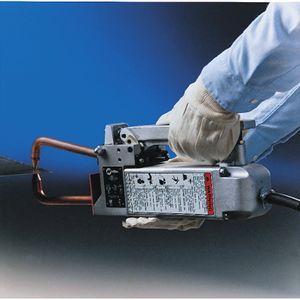Difference between revisions of "Spot Welder"
| Line 11: | Line 11: | ||
|Has description= | |Has description= | ||
|Has certification= | |Has certification= | ||
| − | |Has make= | + | |Has make=Miller |
|Has model=ProtoFlow S N2 | |Has model=ProtoFlow S N2 | ||
|Has group=Circuit Board Design | |Has group=Circuit Board Design | ||
Revision as of 13:18, 8 May 2020
Make: Miller
Model: LMSW-52
Ace: Levi Gibson (lgibson19@georgefox.edu).
Location: Welding Shop
Resistance spot welding is a process in which contacting metal surface points are joined by the heat obtained from resistance to electric current. The Miller LMSW-52 Air-Cooled Spot Welder is a lightweight unit that is portable, easy to operate and excellent for welding mild, galvanized or stainless materials.
Description
- LMSW-52 spot welder manual [1]
Here is an example of TIG welding and some good basic information.
Documentation
Terminology
- Squarewave technology was developed by Miller Electric in 1976 to improve your weld quality and make TIG (tungsten inert gas) welding easier. Miller Squarewave technology provides arc stability when welding aluminum, prevents arc rectification and eliminates tungsten erosion.
- CFH-Cubic Feet Per Hour
- Balance control-The balance control is adjustable to provide additional oxide removal (more cleaning) or less cleaning based on the condition of the material being welded.
- Syncro Start-This allows the choice of Soft, Standard or Hot TIG starts based on the application, lead lengths and tungsten size.
- Digital welding meters-Display both amperage and voltage for viewing of the actual and preset values for greater accuracy and repeatability in your welding procedure.
- Last procedure recall-Simplifies changing your Syncrowave back and forth from aluminum TIG to stainless TIG to Stick welding. One switch makes all the control panel changes.
- Adaptive Hot Start-Stick welding features such as Adaptive Hot Start™ provide good arc strikes without sticking. Once welding, the DIG control makes dynamic adjustments to the welder to ensure smooth E7018 and deep penetration E6010.
Training
Operation
Here are some general setup rules of thumb:
- The CFH gas setting should be roughly 2x the weld cup size. If you were to use a #7 cup the gas flow should be set to 14 CFH.
- The tungsten stick-out from the cup should be no more than the cup diameter. Using a #7 cup would allow for a maximum tungsten stick-out of 7/16"
Demonstration
The demonstration consists of two parts. For the first part you will need to setup the welder and safely attempt to weld a bead. The second part will require you to show knowledge of safely using the grinder and successfully grind a point on a tungsten rod.
General Procedure
- Ensure the material being welded should be clear of any oil or dust
- Turn on the spot welder
- Place the material being welded between the clamps.
- Clamp down on the two pieces of material for no more than 5 seconds.
- Grab workpiece with a set of pliers, and open the clamp.
Safety
- Don't exceed gas pressure past specified value
- Don't weld with gas off
- Always use a welding helmet and proper PPE
- Don't weld in wet gear or standing water
- Don't unscrew regulator adjusting screw all the way out
- Make sure ground clamp is connected to work
Certification
Troubleshooting
Maintenance
General maintenance
The welding torch and cables should be inspected on a regular basis. Look for any signs of cracking or cuts in the cables.
Specific Maintenance Tasks
| Maintenance Procedure | Frequency | Done By |
|---|---|---|
| Check Argon Pressure | Before Use | Student/Tech |
| Check Coolant Flow | Before Use | Student/Tech |
| Inspect collet & Cup | Before Use | Student/Tech |
